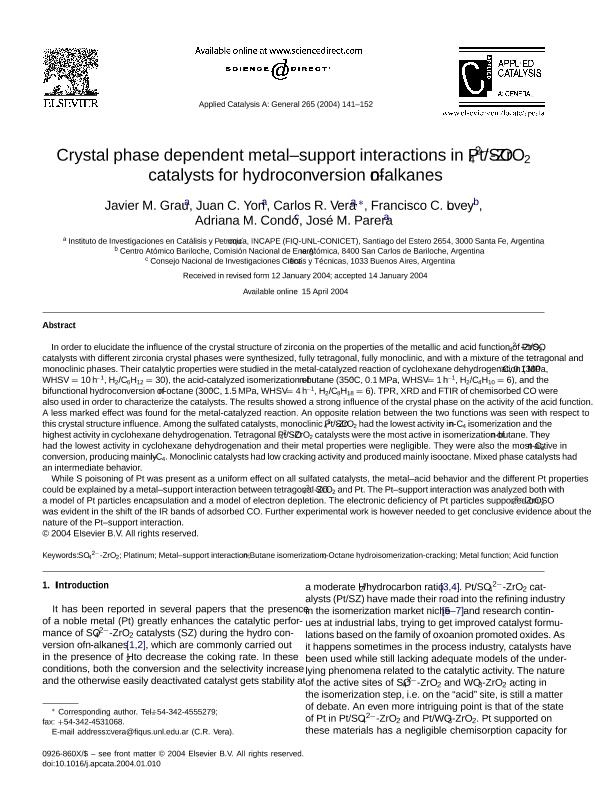Mostrar el registro sencillo del ítem
dc.contributor.author
Grau, Javier Mario

dc.contributor.author
Yori, Juan Carlos

dc.contributor.author
Vera, Carlos Roman

dc.contributor.author
Lovey, Francisco Carlos

dc.contributor.author
Condo, Adriana Maria

dc.contributor.author
Parera, Jose

dc.date.available
2018-08-16T12:59:20Z
dc.date.issued
2004-07
dc.identifier.citation
Grau, Javier Mario; Yori, Juan Carlos; Vera, Carlos Roman; Lovey, Francisco Carlos; Condo, Adriana Maria; et al.; Crystal phase dependent metal-support interactions in Pt/SO42--ZrO2 catalysts for hydroconversion of n-alkanes; Elsevier Science; Applied Catalysis A: General; 265; 2; 7-2004; 141-152
dc.identifier.issn
0926-860X
dc.identifier.uri
http://hdl.handle.net/11336/55835
dc.description.abstract
In order to elucidate the influence of the crystal structure of zirconia on the properties of the metallic and acid function of Pt/SO42−-ZrO2, catalysts with different zirconia crystal phases were synthesized, fully tetragonal, fully monoclinic, and with a mixture of the tetragonal and monoclinic phases. Their catalytic properties were studied in the metal-catalyzed reaction of cyclohexane dehydrogenation (300 °C, 0.1 MPa, , H2/C6H12=30), the acid-catalyzed isomerization of n-butane (350 °C, 0.1 MPa, , H2/C4H10=6), and the bifunctional hydroconversion of n-octane (300 °C, 1.5 MPa, , H2/C8H18=6). TPR, XRD and FTIR of chemisorbed CO were also used in order to characterize the catalysts. The results showed a strong influence of the crystal phase on the activity of the acid function. A less marked effect was found for the metal-catalyzed reaction. An opposite relation between the two functions was seen with respect to this crystal structure influence. Among the sulfated catalysts, monoclinic Pt/SO42−-ZrO2 had the lowest activity in n-C4 isomerization and the highest activity in cyclohexane dehydrogenation. Tetragonal Pt/SO42−-ZrO2 catalysts were the most active in isomerization of n-butane. They had the lowest activity in cyclohexane dehydrogenation and their metal properties were negligible. They were also the most active in n-C8 conversion, producing mainly i-C4. Monoclinic catalysts had low cracking activity and produced mainly isooctane. Mixed phase catalysts had an intermediate behavior. While S poisoning of Pt was present as a uniform effect on all sulfated catalysts, the metal–acid behavior and the different Pt properties could be explained by a metal–support interaction between tetragonal SO42−-ZrO2 and Pt. The Pt–support interaction was analyzed both with a model of Pt particles encapsulation and a model of electron depletion. The electronic deficiency of Pt particles supported on SO42−-ZrO2 was evident in the shift of the IR bands of adsorbed CO. Further experimental work is however needed to get conclusive evidence about the nature of the Pt–support interaction.
dc.format
application/pdf
dc.language.iso
eng
dc.publisher
Elsevier Science

dc.rights
info:eu-repo/semantics/openAccess
dc.rights.uri
https://creativecommons.org/licenses/by-nc-sa/2.5/ar/
dc.subject
So42−-Zro2
dc.subject
Platinum
dc.subject
Metal–Support Interaction
dc.subject
N-Butane Isomerization
dc.subject
N-Octane Hydroisomerization-Cracking
dc.subject
Metal Function
dc.subject
Acid Function
dc.subject.classification
Ingeniería Medioambiental y Geológica, Geotécnicas

dc.subject.classification
Ingeniería del Medio Ambiente

dc.subject.classification
INGENIERÍAS Y TECNOLOGÍAS

dc.title
Crystal phase dependent metal-support interactions in Pt/SO42--ZrO2 catalysts for hydroconversion of n-alkanes
dc.type
info:eu-repo/semantics/article
dc.type
info:ar-repo/semantics/artículo
dc.type
info:eu-repo/semantics/publishedVersion
dc.date.updated
2018-08-13T18:15:17Z
dc.journal.volume
265
dc.journal.number
2
dc.journal.pagination
141-152
dc.journal.pais
Países Bajos

dc.journal.ciudad
Amsterdam
dc.description.fil
Fil: Grau, Javier Mario. Consejo Nacional de Investigaciones Científicas y Técnicas. Centro Científico Tecnológico Conicet - Santa Fe. Instituto de Investigaciones en Catálisis y Petroquímica ; Argentina
dc.description.fil
Fil: Yori, Juan Carlos. Consejo Nacional de Investigaciones Científicas y Técnicas. Centro Científico Tecnológico Conicet - Santa Fe. Instituto de Investigaciones en Catálisis y Petroquímica ; Argentina
dc.description.fil
Fil: Vera, Carlos Roman. Consejo Nacional de Investigaciones Científicas y Técnicas. Centro Científico Tecnológico Conicet - Santa Fe. Instituto de Investigaciones en Catálisis y Petroquímica ; Argentina
dc.description.fil
Fil: Lovey, Francisco Carlos. Comisión Nacional de Energía Atómica; Argentina
dc.description.fil
Fil: Condo, Adriana Maria. Consejo Nacional de Investigaciones Científicas y Técnicas; Argentina
dc.description.fil
Fil: Parera, Jose. Consejo Nacional de Investigaciones Científicas y Técnicas. Centro Científico Tecnológico Conicet - Santa Fe. Instituto de Investigaciones en Catálisis y Petroquímica ; Argentina
dc.journal.title
Applied Catalysis A: General

dc.relation.alternativeid
info:eu-repo/semantics/altIdentifier/doi/http://dx.doi.org/10.1016/j.apcata.2004.01.010
Archivos asociados
